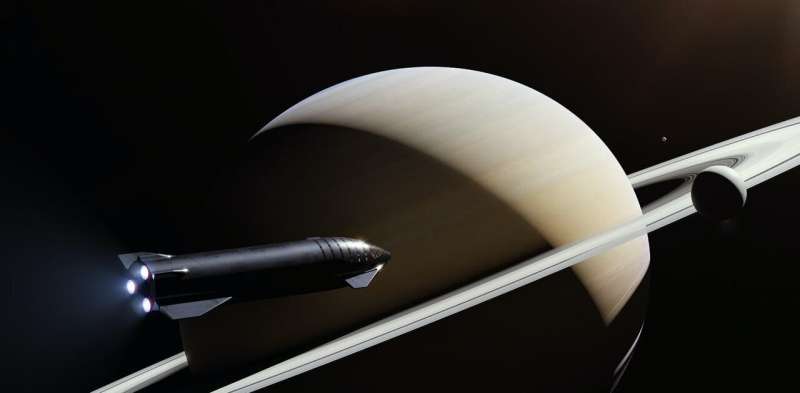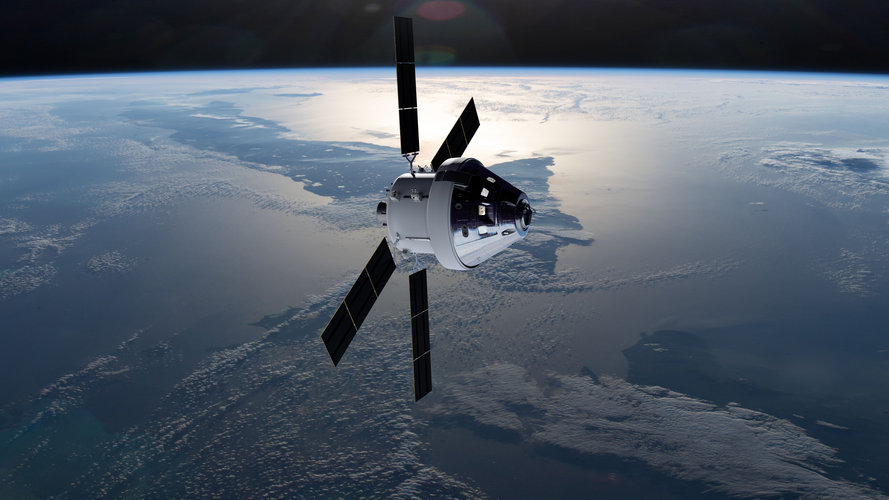
Copernical Team
SpaceX set to launch another batch of Starlink satellites

SpaceX took a couple weeks off, but is ready to send up another batch of Starlink satellites to add its expanding internet empire.
The launch of the Falcon 9 rocket with 46 Starlinks on board is scheduled for 9:44 a.m. from Cape Canaveral Space Force Station. The launch will take a southerly trajectory with the first stage booster, making its 11th flight, attempting a landing the droneship A Shortfall of Gravitas in the Atlantic Ocean.
Space Launch Delta 45′s weather squadron predicts a 90% chance for good weather with the only concerns being cumulus clouds.
The company's last launch ran into issues after its payload of 49 Starlink satellites were deployed, and 40 of them were dragged back down to burn up in Earth's atmosphere after fallout from geomagnetic storm.
That launch was Feb. 3, the sixth for SpaceX so far in 2022, and third Starlink launch of the year. Company founder Elon Musk said last week the company is aiming for 50 launches this year, which would surpass 2021′s record of 31 from Canaveral, Kennedy Space Center and Vandenburg Space Force Base in California.
Jupiter, Saturn, Uranus, Neptune: Why our next visit to the giant planets will be so important, and just as difficult

The giant planets—Jupiter, Saturn, Uranus and Neptune—are some of the most awe-inspiring in our solar system, and have great importance for space research and our comprehension of the greater universe.
Yet they remain the least explored—especially the "ice giants" Uranus and Neptune—due to their distance from Earth, and the extreme conditions spacecraft must survive to enter their atmospheres. As such, they're also the least understood planets in the solar system.
Our ongoingresearch looks at how to overcome the harsh entry conditions experienced during giant planet missions. As we look forward to potential future missions, here's what we might expect.
But first, what are giant planets?
Unlike rocky planets, giant planets don't have a surface to land on. Even in their lower atmospheres they remain gaseous, reaching extremely high pressures that would crush any spacecraft well before it could land on anything solid.
There are two types of giant planets: gas giants and ice giants.
The larger Jupiter and Saturn are gas giants. These are mainly made of hydrogen and helium, with an outer gaseous layer and a partially liquid "metallic" layer below that.
Small companies partake in ESA’s European Service Module

ESA has involved ten European countries in the development of the European Service Module which is part of NASA’s Orion spacecraft soon to launch to the Moon from NASA’s Kennedy Space Center in Florida. Four European small and medium-sized enterprises (SMEs) took part.
New Space Station experiments study flames in space
 Americans can feel safer in their homes now than decades ago thanks to studies and standards that have removed highly flammable materials in clothing, beds, and furniture. NASA relies on similar studies and standards to protect astronauts when selecting materials for spacesuits and spacecraft.
But fire behaves differently in space. Changes in gravity and air flow can alter the way it sprea
Americans can feel safer in their homes now than decades ago thanks to studies and standards that have removed highly flammable materials in clothing, beds, and furniture. NASA relies on similar studies and standards to protect astronauts when selecting materials for spacesuits and spacecraft.
But fire behaves differently in space. Changes in gravity and air flow can alter the way it sprea UNSW Sydney buys nanosatellite bus from NanoAvionics
 The University of New South Wales (UNSW) in Sydney, Australia, has contracted mission integrator NanoAvionics to build a nanosatellite bus for UNSW's satellite innovation laboratory. As part of the collaboration, NanoAvionics will deliver a 6U nanosatellite bus fully assembled and tested on a functional level, ready for its research and educational purposes. Payload integration for laboratory te
The University of New South Wales (UNSW) in Sydney, Australia, has contracted mission integrator NanoAvionics to build a nanosatellite bus for UNSW's satellite innovation laboratory. As part of the collaboration, NanoAvionics will deliver a 6U nanosatellite bus fully assembled and tested on a functional level, ready for its research and educational purposes. Payload integration for laboratory te PathFinder Digital delivers new range of "BAT" Satellite Terminals
 PathFinder Digital is now delivering the next generation of its "BAT" line of ground mobile satellite communication terminals designed and built for military applications. For over ten years, PathFinder has been providing the U.S. Army, U.S. Air Force, U.S. Marines and U.S. Navy ruggedized vehicle mounted and case based VSATs known as the "BAT" family of terminals. PathFinder's BAT-850 VSAT is t
PathFinder Digital is now delivering the next generation of its "BAT" line of ground mobile satellite communication terminals designed and built for military applications. For over ten years, PathFinder has been providing the U.S. Army, U.S. Air Force, U.S. Marines and U.S. Navy ruggedized vehicle mounted and case based VSATs known as the "BAT" family of terminals. PathFinder's BAT-850 VSAT is t "Impossible" breakthrough brings fusion energy device closer to realization
 Scientists have achieved a remarkable breakthrough in the conceptual design of twisty stellarators, experimental magnetic facilities that could reproduce on Earth the fusion energy that powers the sun and stars. The breakthrough shows how to more precisely shape the enclosing magnetic fields in stellarators to create an unprecedented ability to hold the fusion fuel together.
"The key thing
Scientists have achieved a remarkable breakthrough in the conceptual design of twisty stellarators, experimental magnetic facilities that could reproduce on Earth the fusion energy that powers the sun and stars. The breakthrough shows how to more precisely shape the enclosing magnetic fields in stellarators to create an unprecedented ability to hold the fusion fuel together.
"The key thing AFRL holds directed energy and kinetic energy wargaming experiment
 The Air Force Research Laboratory's Directed Energy Directorate hosted a collaborative wargame with its sister AFRL unit, the Munitions Directorate, at Kirtland AFB, Jan. 24-28, 2022. The Directed Energy and Kinetic Energy Directed Energy Utility Concept Experiment, or DEKE DEUCE, explored synergies between directed energy and kinetic concepts in the future battlespace.
"DEKE DEUCE require
The Air Force Research Laboratory's Directed Energy Directorate hosted a collaborative wargame with its sister AFRL unit, the Munitions Directorate, at Kirtland AFB, Jan. 24-28, 2022. The Directed Energy and Kinetic Energy Directed Energy Utility Concept Experiment, or DEKE DEUCE, explored synergies between directed energy and kinetic concepts in the future battlespace.
"DEKE DEUCE require AFRL holds collaborative space domain awareness event
 The Air Force Research Laboratory Space Vehicles and Directed Energy Directorates hosted the 9th Annual Space Domain Awareness Leadership Workshop at Kirtland AFB, January 25 - 27. More than 100 senior leaders from across the Department of Defense and government laboratories participated in the combined in person and virtual event.
Those organizations participating included the Space Syste
The Air Force Research Laboratory Space Vehicles and Directed Energy Directorates hosted the 9th Annual Space Domain Awareness Leadership Workshop at Kirtland AFB, January 25 - 27. More than 100 senior leaders from across the Department of Defense and government laboratories participated in the combined in person and virtual event.
Those organizations participating included the Space Syste A game-changing satellite communication technology from Aston and Pulse Power
 Aston University has been working with Pulse Power and Measurement Ltd (PPM) through a knowledge transfer partnership (KTP) to develop a game-changing approach to technology used in the radio-over-fibre communications industry.
The project will look to transform the connection between low earth orbit (LEO) satellite antenna dishes and modems through optics rather than electronics, deliveri
Aston University has been working with Pulse Power and Measurement Ltd (PPM) through a knowledge transfer partnership (KTP) to develop a game-changing approach to technology used in the radio-over-fibre communications industry.
The project will look to transform the connection between low earth orbit (LEO) satellite antenna dishes and modems through optics rather than electronics, deliveri 
